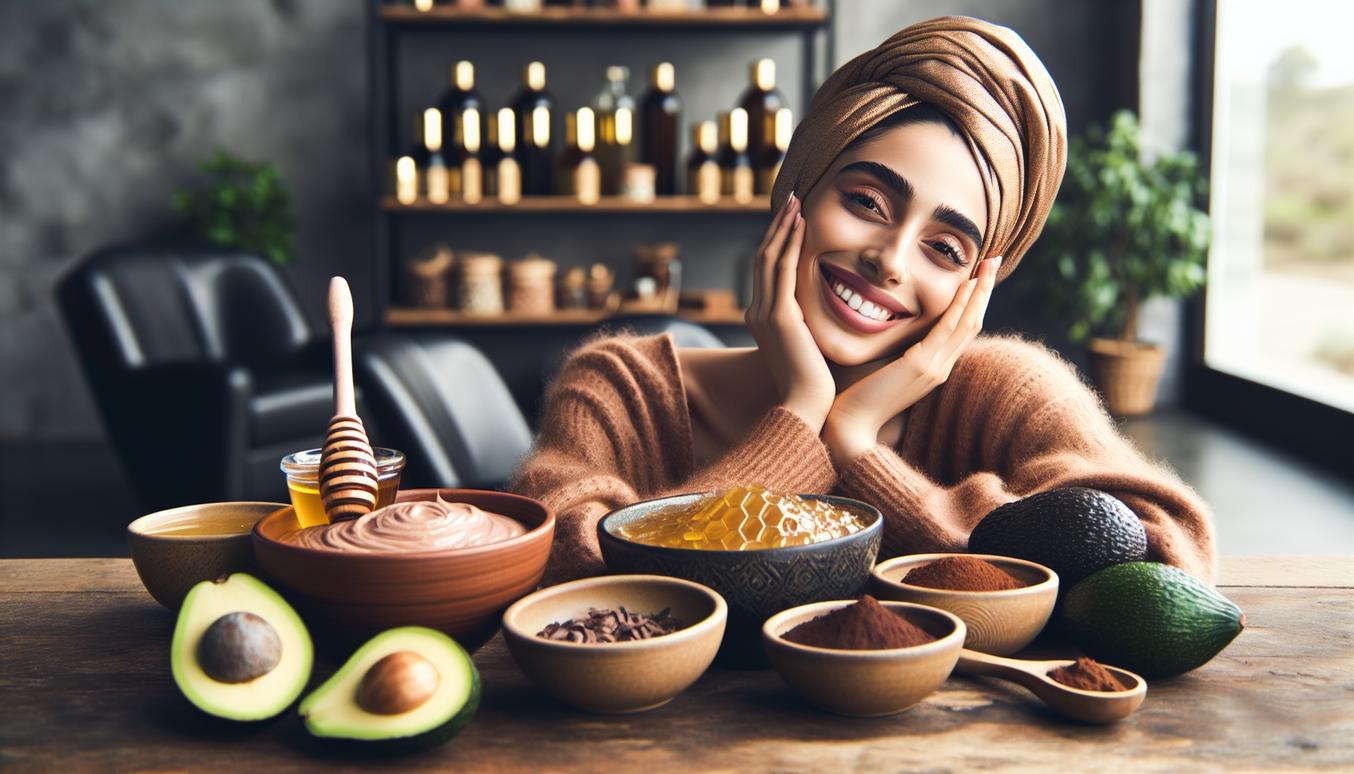The Ultimate DIY Hair Mask Guide: Transform Your Hair with Simple Pantry Recipes
Welcome to your go-to guide for creating effective, nourishing, and incredibly simple hair treatments right from your kitchen. Forget expensive salon treatments; the secret to luscious, healthy hair might just be sitting in your pantry. A DIY hair mask is a cost-effective and natural way to give your hair a concentrated dose of the nutrients it craves. Whether you’re battling dryness, breakage, or a lackluster scalp, there’s a homemade solution for you.
This guide will walk you through everything you need to know, from identifying your hair’s specific needs with easy at-home tests to whipping up the perfect recipe. Get ready to unlock the power of natural ingredients and give your hair the love it deserves.
How to Evaluate Your Hair’s Needs at Home
Before you start mixing, it’s crucial to understand what your hair is asking for. Is it thirsty for moisture, crying out for protein, or is your scalp in need of some TLC? These simple tests will give you the answer.
The Porosity Test
Porosity determines how well your hair can absorb and retain moisture. It’s a game-changer for choosing the right ingredients.
- How to do it: Drop a clean strand of hair into a glass of water.
- If it floats: You have low porosity hair. The cuticle is tightly packed, making it hard for moisture to get in. Look for lighter oils and humectants like honey.
- If it sinks slowly: You have medium porosity hair. This is the ideal, as your hair absorbs and retains moisture well. You can use a balance of moisturizing and protein treatments.
- If it sinks quickly: You have high porosity hair. Your hair has gaps in the cuticle, so it absorbs moisture easily but loses it just as fast. It needs sealing oils and protein to fill in the gaps.
The Elasticity (Stretch) Test
This test helps you figure out your hair’s moisture-protein balance.
- How to do it: Take a single wet strand of hair and gently stretch it.
- If it doesn’t stretch much and snaps easily: Your hair likely needs moisture. It’s brittle and thirsty. Focus on hydrating ingredients like avocado and banana.
- If it stretches and feels mushy or gummy: Your hair has too much moisture and needs protein. This is known as hygral fatigue. Reach for ingredients like egg or Greek yogurt.
- If it stretches slightly then returns to its original length: Your hair has a healthy moisture-protein balance. Congratulations! You can alternate between masks to maintain its health.
Key Natural Ingredients and Their Hair Superpowers
Your kitchen is a treasure trove of hair-loving ingredients. Understanding what each one does will help you customize your perfect DIY hair mask. Here’s a breakdown of common pantry staples and their benefits.
For Deep Moisture
- Avocado: Rich in oleic acid and monounsaturated fats, it penetrates the hair shaft to moisturize deeply. It’s also packed with vitamins B and E, which help strengthen the hair.
- Banana: Contains potassium and natural oils that soften hair and protect its elasticity, preventing split ends and breakage. The silica in bananas can also help make hair stronger and thicker.
- Honey: A natural humectant, which means it draws moisture from the air into your hair. It’s also an emollient, helping to smooth and soften your locks.
- Olive Oil: Full of fatty acids that coat the hair shaft, sealing in moisture and adding shine. It’s excellent for dry, thick, or high porosity hair.
For Building Strength
- Egg: The yolk is rich in fats and vitamins for moisturizing, while the white is packed with protein enzymes. A whole egg provides a fantastic balance for strengthening and conditioning.
- Greek Yogurt: Contains lactic acid to cleanse the scalp and proteins to nourish and strengthen the hair strands. It helps fortify the hair from root to tip.
For Scalp Health
- Apple Cider Vinegar (ACV): Helps clarify the scalp by removing product buildup. Its acidic nature can also help balance the scalp’s pH and close the hair cuticle, leading to shinier hair.
- Aloe Vera: Soothing and anti-inflammatory, aloe vera is perfect for irritated scalps. It also contains enzymes that can help promote healthy hair growth by clearing dead skin cells from follicles.
- Oatmeal: Its anti-inflammatory properties can soothe an itchy, dry scalp. It also contains saponins, which act as gentle natural cleansers.
Quick Pantry Recipes for Every Hair Concern
Ready to get started? Here are three simple, effective recipes you can whip up in minutes. For best results, blend all ingredients until smooth to avoid clumps.
The Intense Moisture DIY Hair Mask
Best for: Dry, brittle, or low elasticity hair.
- Ingredients: 1/2 ripe avocado, 1 ripe banana, 1 tablespoon of olive oil.
- Instructions: Blend all ingredients until completely smooth. Apply to damp hair, focusing on the ends. Leave on for 20-30 minutes, then rinse thoroughly with lukewarm water.
The Strengthening Protein DIY Hair Mask
Best for: Gummy, over-moisturized, or high porosity hair.
- Ingredients: 1 egg, 2 tablespoons of Greek yogurt, 1 tablespoon of honey.
- Instructions: Whisk the ingredients together. Apply to damp hair from root to tip. Cover with a shower cap and leave on for 15-20 minutes. Important: Rinse with cool water to avoid cooking the egg in your hair.
The Soothing Scalp DIY Hair Mask
Best for: Itchy, flaky, or oily scalps.
- Ingredients: 1/2 cup of plain cooked oatmeal (cooled), 1 tablespoon of honey, 2 tablespoons of aloe vera gel.
- Instructions: Combine the ingredients into a paste. Part your hair and apply directly to the scalp, gently massaging it in. Let it sit for 20 minutes before rinsing.
Simple Single-Ingredient Masks for a Quick Fix
Don’t have time for a full recipe? These single-ingredient wonders can provide a quick boost when you’re short on time.
- Coconut Oil: Use as a pre-shampoo treatment for deep conditioning. Apply to dry hair, leave for 30 minutes, then shampoo and condition as usual.
- Honey: Mix a tablespoon of honey with a little water to make it less sticky. Apply to damp hair for 15 minutes for a quick shine boost.
- Mashed Avocado: If you have an overripe avocado, mash it up and apply it directly to your ends to combat frizz and add moisture.
Your Step-by-Step DIY Hair Mask Application Guide
Applying your homemade mask correctly ensures you get the maximum benefits.
- Start with clean, damp hair. Shampoo your hair first to remove any product buildup, then gently towel-dry until it’s damp, not dripping.
- Section your hair. Divide your hair into 4-6 sections to ensure even application.
- Apply the mask. Using your fingers or a brush, apply the **DIY hair mask** from the roots to the ends, or just on the areas that need it most (e.g., ends for dryness, scalp for irritation).
- Cover and wait. Tuck your hair into a shower cap or wrap it in a warm towel. This traps heat, which helps the ingredients penetrate the hair shaft more effectively.
- Let it sit. Most masks need 15-30 minutes to work their magic. Avoid leaving protein masks on for too long, as this can cause stiffness.
- Rinse thoroughly. Use lukewarm or cool water to rinse the mask out completely. You may need to rinse for a few minutes to get everything out. Follow with a conditioner to seal the cuticle, if needed.
How Often Should You Use a DIY Hair Mask?
The ideal frequency depends on your hair type and its condition.
- Fine or Oily Hair: Once every 2 weeks. Over-masking can weigh your hair down.
- Normal or Wavy Hair: Once a week is a great maintenance schedule.
- Dry, Curly, or Damaged Hair: 1-2 times per week to provide consistent moisture and repair.
Listen to your hair! If it feels greasy, cut back. If it still feels dry, you might need to mask more often.
Safety First: Patch Testing and Allergy Checks
Even natural ingredients can cause reactions. Before applying any new **DIY hair mask** all over your head, it is essential to perform a patch test.
- How to Patch Test: Apply a small amount of the mixture to a discreet area of skin, like behind your ear or on your inner elbow.
- Wait 24 Hours: Monitor the area for any signs of redness, itching, or irritation.
- Proceed with Caution: If no reaction occurs, you’re likely safe to proceed. If you experience any irritation, wash the area immediately and do not use the mask.
Tips for Storage, Preparation, and Sourcing Ingredients
- Make it Fresh: A **DIY hair mask** is best made fresh for each use, especially when using perishable ingredients like egg, banana, or avocado.
- No Storing: Do not store leftover masks containing raw eggs or dairy, as they can spoil quickly and grow bacteria.
- Blend Well: For a smooth, easy-to-apply mask, use a blender. This prevents chunks of food from getting stuck in your hair.
- Source Smartly: Use fresh, ripe ingredients. Organic is a great choice if accessible, as it ensures you’re not putting pesticides on your scalp.
Troubleshooting Common Mask Mishaps
Sometimes, a DIY experiment doesn’t go as planned. Here’s what to do if you encounter a problem. In your 2025 haircare strategy, understanding how to fix these small issues will make your DIY journey much smoother.
- My hair feels greasy or weighed down. You likely used too much oil or didn’t rinse thoroughly. Use a clarifying shampoo on your next wash to remove the excess residue.
- My hair feels stiff and brittle. This is a classic sign of protein overload. Your hair has too much protein and not enough moisture. Use an intensely hydrating, protein-free mask next time to restore balance.
- The mask was hard to wash out. The mixture was probably too clumpy or thick. Next time, blend your ingredients until they are completely smooth, and consider adding a little more liquid (like water or aloe vera juice) to get a better consistency. Applying shampoo *before* wetting your hair can also help break down stubborn oils.
Frequently Asked Questions
Can I leave a DIY hair mask on overnight?
It depends on the ingredients. Moisturizing masks with oils, aloe, or honey can often be left on overnight for a deep conditioning treatment (be sure to protect your pillowcase). However, never leave masks with egg or apple cider vinegar on overnight, as they can damage your hair or irritate your scalp with prolonged contact.
Do I apply a DIY hair mask to wet or dry hair?
Damp hair is generally best. It’s clean from product buildup and the cuticles are slightly open, making it primed to absorb the nutrients from the mask. Applying to very wet hair can dilute the mask, while applying to dry hair can make it difficult to distribute evenly.
How do I get an oily mask out of my hair easily?
The trick is to apply shampoo to your oily hair *before* you add water. Emulsify the shampoo with the oil first, working it through your hair. Then, slowly add water and lather as usual. This helps the shampoo bind to the oil and wash it away more effectively.
References and Further Reading
Ready to continue your journey into natural haircare? These resources provide even more information and inspiration.
- For a deeper dive into more recipes and techniques, explore this excellent DIY hair mask guide.
- To understand the science behind how what you eat affects your hair, check out this comprehensive hair nutrition guide.





